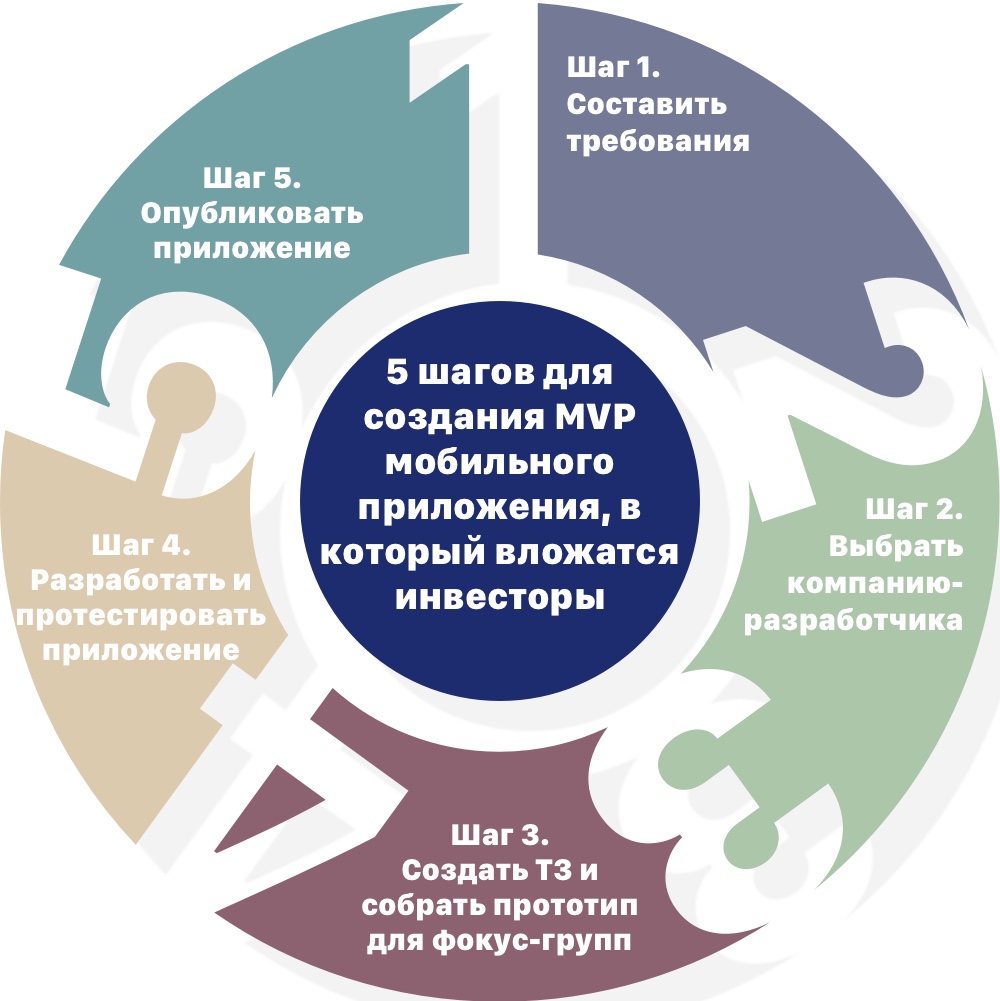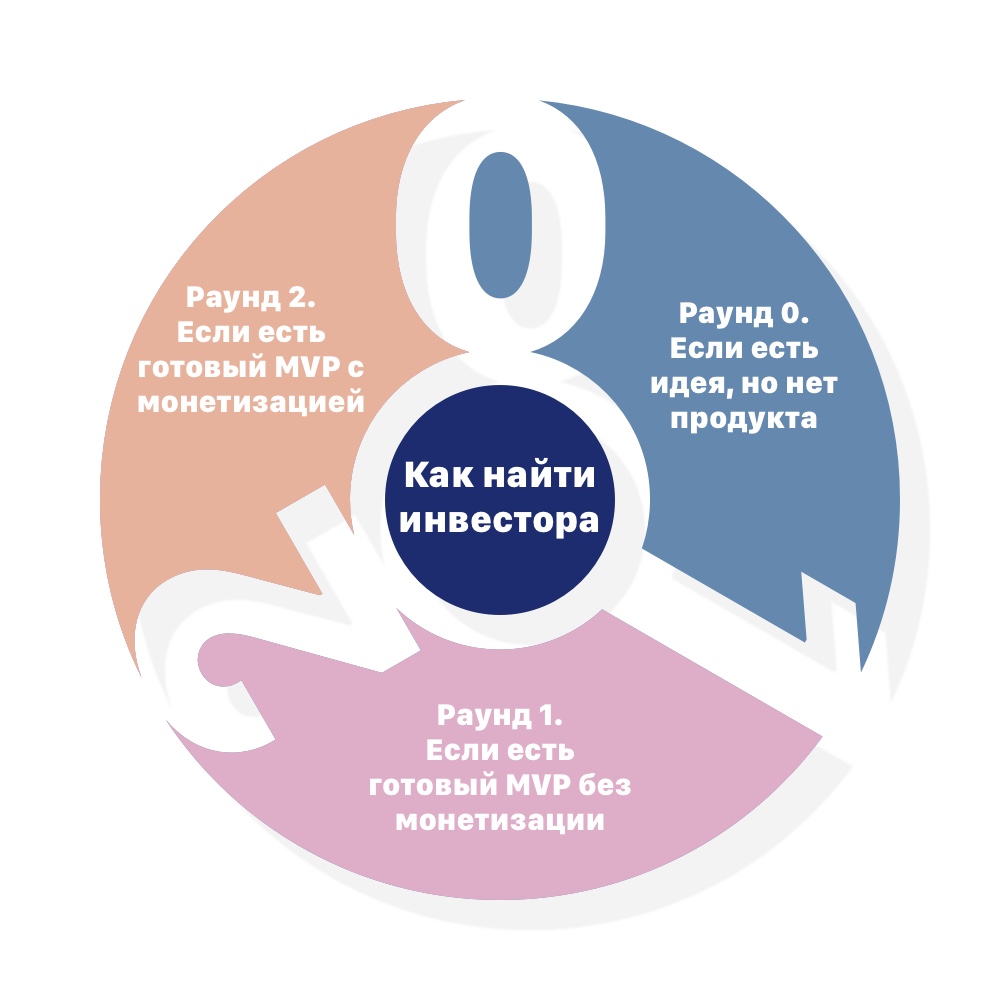How to create an MVP application that investors will invest in
Step 1. Make requirements
Step 2. Choose a development company
Step 3. Create TK and assemble a prototype for focus groups
Step 4. Develop and test the application
Step 5. Publish the application

How to find an investor?
Round 0. If there is an idea, but no product
Round 1. If there is a ready MVP without monetization
Round 2. If there is a ready MVP with monetization
Other ways to attract investment
useful links

MVP (Minimum Viable Product) - literally the minimum viable product.
The article contains useful tips and answers to the following questions:
- What does “ideal MVP” look like for investors?
- What steps should be taken to create an “ideal MVP”?
- What are project development rounds and in what round which investors can be attracted?
- Where can I find investors?
- How to present an idea to investors depending on the round?
- How to choose a developer to implement and support a mobile startup application?
You got the idea to create a mobile application, didn’t find analogues, and realizing how many people are willing to pay for its functionality, you realized that you need to act.
We received a cost estimate from many agencies and came to the conclusion that your funds are not enough to launch a high-quality application development and marketing to launch a project.
If this step has not yet been completed - at the end there are a few useful links to sites that help make an independent assessment of the cost of development.
Ideas fly in the air and to delay is to give the idea to someone who was able to attract investors.
You can come to an investor with just one idea, but if you have a budget, then for a start it is better to develop an MVP of a mobile application and already find investments with it.
Firstly, if the idea is really worthwhile, then just setting it out to the investor and receiving a refusal, after a while at the next presentation you may accidentally find out that the idea is almost realized by those people who did not want to invest in your project.
Business accelerators, promising to attract investors, can do the same thing, because the theory of the probability of such events does not exclude.
If you come to investors as the full owner of the application, everything plays with other colors.
MVP (Minimum Viable Product) - literally the minimum viable product.
It is applicable to a mobile application, viable and equally useful to the user, because if the goal of creation was monetization, then in the first version of the application there must necessarily be functionality that is valuable to the audience.
The audience should be either large or with a highly specialized need and problem that existing services and applications cannot solve.
The problem and the need of the audience in an ideal situation arises with a certain periodicity, and not once.
5 steps to create an MVP mobile application that investors will invest in

Make requirements for MVP that will meet the expectations of users and investors.
A good MVP in the understanding of investors should have a monetization formula:

It may be necessary to deduct a 30% APP STORE commission from “Income”, so you need to clearly understand what payments these fees are charged for, information about which application features will have to be rolled back is available on the official apple website.
If everything is clear with the size of the audience and monetization, you can proceed to the next step.

The second step will be the choice of the developer, and not the writing of the technical task, since it is better for the final executors to entrust the description of the functional and the choice of development technologies. If you are not an IT specialist, it will be very difficult to compose a TOR on your own, in which all the nuances will be taken into account.
In the next paragraph there will be recommendations for the preparation of materials for developers, reducing the cost of developing TK (spoiler: it is you, as the author of the idea, who can best describe user stories).
Signs of companies that are ideal for implementing and supporting mobile startups:
Companies from the region , and they do not have customers of the "giants" whom they have been supporting for more than a year, as in large metropolitan companies.
Such developers have ambitions and adequate pricing, will readily take up the implementation of MVP and will not be relegated to the background at the crucial moment, because a large client suddenly wanted a massive update.
Developers who do not obscure by naming the cost (it is likely that you did not have a detailed statement of work at the cost request step and everyone called the cost plug differently).
Pay attention to commercial offers, in which there is a breakdown of the work indicating the person hours spent on specific work, compare the amount of information that the developers requested for an assessment, the more brief the project was and the deeper the project was considered the more appropriate the company's approach.
Companies with a flexible approach to the stages of payment and development.
Study the NDA (non-disclosure agreement for commercially valuable information) and the model contract of the developer company and be sure to discuss the possibility of development and payment broken down by stages, each of which has a tangible result either in the form of source code or as part of a fully completed work, for example: design stage - when accepting the work, all materials for layout and layouts in vector format were transferred, the second stage of layout is completely completed and implemented exactly according to the previously agreed layouts. If the company refuses this format you proposed, this is an occasion to think.

Drafting technical specifications and assembling a clickable prototype for a focus group
To write the terms of reference yourself:
Describe all (and not just ideal) user steps, taking into account all possible scenarios of user interaction with the application (an example of one of the scenarios “when something went wrong” is a disconnection of the Internet connection or an incoming call when an operation is performed in the application. should happen? For example, caching data for resending, etc.)
Investigate the market of mobile devices for the active use of certain device models for your audience and the capabilities of these devices regarding the functions you need. This is necessary to indicate in the TOR the versions of mobile OS that the developer needs to support (including this affects the cost, more versions have a higher cost).
To think over the structure of the interface ensuring all users have the same UX (user experience). Example: authorization using Touch ID. Touch ID itself is not available on all devices, but users who have changed the device while using the mobile application also want to use this function, so the ability to set a fingerprint for authorization should not only be on the registration screens, but also in profile settings, for example.
In the given example, the scenario is “not fatal,” but just worsening the user experience (and it’s good if such an ill-conceived scenario is just one way or another, the annoyance of the user turns into a snowball), but in some cases a missed and ill-conceived requirement for functionality can be very critical for using the application , for example: the user is forced through the application to fill in many fields of the application (such a business process) and suddenly the notorious incoming call ... Are all the filled fields empty? If so, it’s sad ... Who is to blame? Was it in TK?
To prescribe the interaction architecture of the database, server, client applications, administrative panel - only a specialist can make a correct description.
Many nuances must be taken into account.
The second option is to order the terms of reference from the developers:
answer their questions and get high-quality TK.
In most cases, the terms of reference are written in parallel with the development of the design of the application or with its prototyping.
It is convenient and rational.
From screen layouts, you can assemble a clickable prototype, with the help of which later you can check the usability and the correctness of the user’s steps laid down in the design.
Such a prototype can be assembled using the free services InVision, Moqups, Marvelapp.
The third way is the middle ground between the first and second: you describe in detail the scenarios (and illustrate them in prototypes) and give them to the developers for the design of TK.
The terms of reference describing the scenarios that you reflected in the prototypes, supplemented by the developers with a description of the technical “pitfalls”, will cost several times less regarding the technical specifications that the studio would have made with you from scratch.

Everything is simple with development because there is a TK and a design, but testing needs to be paid special attention, for a good one, the developer should provide a test report in the format of closed check sheets with a link to devices and platforms, confirming that all the scenarios provided for the TK work on supported devices correctly.

The fifth step is publication in the markets, on the one hand it’s the finish line and there’s only one caveat not to tie events related to promotion to any dates before the review in APP STORE, just imagine how unpleasant it is to organize an event whose purpose is to demonstrate the application and the last moment to find out that it is not possible to present it, since it has not yet been published. Therefore, first go through the review and only then set the dates for the presentations.
Project development rounds and where to look for an investor depending on the round:

How to attract investors if you are on the round “0”?
In the round which is called zero there is no product as such and the best option for finding investment is an investment (or an impressive discount) from the project developers.
Realizing the project as internal (in other words, “its own” with the potential for profit), the developers will definitely choose a scalable architecture, an optimal technology stack, safe data storage methods and other components that ensure the stable development of the project and rational costs for third-party services.
Tip If you are on the round “0” - describing the idea to developers, focus on the monetization scheme of the service, suggest how quickly competitors appear who try to reproduce the functionality of your service.
These two points (in addition to the uniqueness of the idea) will be especially important for deciding whether to invest in your project. They imply a conditional load (which the developer will compare with the available work resources) and an understanding is formed of how often and at what speed it is necessary to issue updates to remain the most successful of such services (maybe your idea is not 100% unique and you are creating the best version of the existing one) service, then this item is especially important).
Accordingly, Business Accelerators themselves (in the end of the article, a list of the most popular) are certainly useful for projects that cannot independently conduct a qualitative study of the audience and competitors, build a development and promotion plan, moreover, accelerators have “distribution channels” for foundations and business angels. But still, if you already have a general idea of the project for all the points that I described above, you should not “pay twice”, since you can go to investors and the business of angels yourself and nobody canceled the consulting.

How to attract investors if you are on round “1”?
When a project is ready to be launched and its full functionality can be demonstrated at least on test users, it is possible to broadcast the idea to a business (a specific company), especially if the project has specifics of usefulness for specialists in a particular field.
If the project does not have such specifics, it will be easier to convey information about the potential and prospects of the application to a private investor or businessman with high social activity who is interested in it and who has at least a basic idea of how it projects to monetize, it will be more difficult for the “conservative business” to present MVP it is obvious .
Where do the first-round projects catch the business of angels?
The most appropriate format is a demo day or the so-called investor day. Information about planned demo days is freely available by all large companies.
here, by the way, an interesting review from the participant of such a demo day which gives recommendations on preparing for the performance https://vc.ru/flood/43855-den-investora-demo-day-ili-kak-ya-prezentoval-startap-za-3 -minuty

If you are on round number 2, then the best option for your experience will be the lack of need for investment since a useful product that is already monetized is more likely to be supported and developed independently (at least the mobile application we are considering is a product).
If investments are nevertheless necessary then:
- We are looking for Invest funds (links to websites and fund reviews at the end of the article)
- We look at what projects they invested over the past 5 years
- We look carefully at these projects (if they began to belong to investors completely, and the original owner has sunk into oblivion, then maybe this is a black investor with not the most honest terms of the contract)
- If the original owner is still in the project, then we carefully study all the information that investors can request (sometimes it is on the site), for example, questionnaires and special briefs.
- We look at how they present their projects, for this we read blog articles, interviews with their top managers and reports on the success of the projects in which they invested.
- We form for ourselves a thesis list of their values and the categories on which they focus.
- Then, understanding the values of the fund and the focus of priorities, we prepare materials:
- Presentation
- In the presentation, we reflect the main idea, we are talking about competitors or their absence; if there are competitors, we consider them in terms of “we will not repeat mistakes” or “we want to repeat successful experience in another = free market”
- Business plan (in which we necessarily consider the unit economy)
- Marketing plan (we describe the cost of attracting users with the most detailed and competent description of the budget allocation for specific advertising channels)
- We fill in their materials (questionnaires, summary forms, etc.)
Are there other ways to “get funds for the project”?
- Crowdfunding sites are good for socially useful projects.
- State grants (for high-tech and highly specialized or even developed for a specific grant).
- Grants of large companies (may have different values and goals, but it also makes sense to pay attention to them).
- Competitions, for example, a competition in the framework of the annual start-up conference of the Startup Village forum in Skolkovo in 2019 for early-stage projects offer the main prize of 2,000,000 rubles and up to 5,000,000 for the development of the most interesting ready-made service (product).

A digest of useful links in the continuation of the topic:
Publications and electronic edition of Roman Yankovsky
(The author of the book "Startup Law", "Venture Lawyer", Ph.D., a teacher at Moscow State University.)
Ways to monetize a mobile application
Overview of business accelerators popular among Russian IT startups :
Startup Academy. LNA "Skolkovo"
[Accelerator from Sberbank and 500] (Startups https://www.sberbank-500.ru/ )
HSE Accelerator
Accelerator IIDF
Y combinator
MSU Business Accelerator
Philtech Accelerator
Y combinator
Independently assess the cost of development:
https://estimatemyapp.com/
https://is.gd/03lzxa
https://venturepact.com/mobile_app_price_calculator
http://calculator.kinvey.com/mbaas-savings-calculator